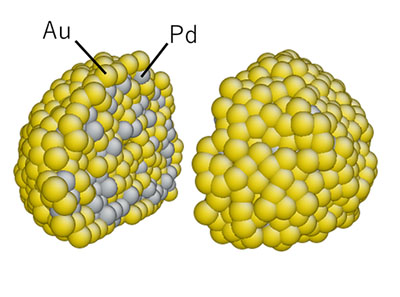Bimetallic Nanoparticles: Synergistic Properties for Enhanced Applications
What are Bimetallic Nanoparticles?
Bimetallic nanoparticles are a class of nanomaterials composed of two distinct metal elements, which can be arranged in various structures such as core-shell, alloyed, or segregated architectures. These nanoparticles exhibit unique properties that arise from the synergistic combination of the two metals, often surpassing the performance of their monometallic counterparts. The enhanced properties of bimetallic nanoparticles make them highly attractive for a wide range of applications, including catalysis, sensing, imaging, and energy storage.

Key Concepts in Bimetallic Nanoparticles
The unique properties of bimetallic nanoparticles arise from several key concepts:
- Synergistic Effects: The combination of two metals in a nanoparticle can lead to enhanced properties that are not achievable with either metal alone. This synergy can result from electronic, geometric, or ensemble effects, where the interaction between the two metals modifies their electronic structure, atomic arrangement, or collective behavior.
- Tunable Composition: The composition of bimetallic nanoparticles can be precisely controlled by adjusting the ratio of the two metals during synthesis. This tunability allows for the optimization of nanoparticle properties for specific applications. For example, varying the composition of platinum-palladium nanoparticles can significantly impact their catalytic activity and selectivity.
- Structural Diversity: Bimetallic nanoparticles can adopt various structures, such as core-shell, alloyed, segregated, or mixed architectures. Each structure exhibits distinct properties and advantages. Core-shell nanoparticles, for instance, can combine the stability of one metal with the catalytic activity of another, while alloyed nanoparticles may exhibit enhanced electronic properties due to the homogeneous mixing of the two metals.
Synthesis of Bimetallic Nanoparticles
Several methods have been developed for the synthesis of bimetallic nanoparticles, each with its own advantages and challenges:
Co-Reduction Method
The co-reduction method involves the simultaneous reduction of two metal precursors in the presence of stabilizing agents, such as surfactants or polymers. This method allows for the formation of alloyed or mixed bimetallic nanoparticles with controlled sizes and compositions. However, achieving a uniform distribution of the two metals can be challenging due to differences in their reduction potentials.
Seed-Mediated Growth
Seed-mediated growth is a two-step process where pre-formed nanoparticles of one metal (seeds) are used as nucleation sites for the growth of the second metal. This method is particularly suitable for the synthesis of core-shell bimetallic nanoparticles, where the seeds form the core and the second metal grows as a shell around it. Seed-mediated growth offers better control over the nanoparticle structure and composition compared to co-reduction.
Galvanic Replacement
Galvanic replacement is a facile method for the synthesis of hollow or porous bimetallic nanoparticles. It involves the reaction between a metal nanoparticle (template) and a solution containing ions of a more noble metal. The difference in reduction potentials drives the oxidation of the template metal and the reduction of the noble metal ions, resulting in the formation of a hollow or porous structure. Galvanic replacement offers a simple route to bimetallic nanoparticles with unique morphologies and enhanced surface areas.
Applications of Bimetallic Nanoparticles
Bimetallic nanoparticles find applications in various fields due to their exceptional properties:
Catalysis
Bimetallic nanoparticles are widely used as catalysts for chemical reactions, such as hydrogenation, oxidation, and coupling reactions. The synergistic effects between the two metals can enhance the catalytic activity, selectivity, and stability compared to monometallic catalysts. For example, platinum-palladium nanoparticles have shown remarkable performance in the catalytic oxidation of carbon monoxide and the reduction of nitrogen oxides in automotive exhaust systems.
Sensing and Imaging
Bimetallic nanoparticles exhibit unique optical and magnetic properties that make them attractive for sensing and imaging applications. Gold-silver nanoparticles, for instance, have been used as colorimetric sensors for the detection of heavy metal ions, while iron-platinum nanoparticles have shown promise as contrast agents for magnetic resonance imaging (MRI).
Energy Storage and Conversion
Bimetallic nanoparticles play a crucial role in the development of advanced energy storage and conversion devices. Platinum-ruthenium nanoparticles are used as electrocatalysts in direct methanol fuel cells, where they catalyze the oxidation of methanol and the reduction of oxygen. Nickel-cobalt nanoparticles have been explored as high-performance electrode materials for supercapacitors and lithium-ion batteries.
Challenges and Future Perspectives
Despite the remarkable progress in the synthesis and application of bimetallic nanoparticles, several challenges remain. One of the main challenges is the scalable and cost-effective production of bimetallic nanoparticles with well-defined structures and compositions. The development of green and sustainable synthesis methods is also an important consideration for the widespread use of these nanomaterials.
Future research in bimetallic nanoparticles will focus on the rational design and optimization of nanoparticle structures for specific applications. The integration of computational modeling and machine learning techniques will aid in the prediction and discovery of novel bimetallic nanoparticle compositions with enhanced properties. Additionally, the exploration of multimetallic nanoparticles (containing three or more metals) will open up new possibilities for tailoring the properties of these nanomaterials for advanced applications.
Further Reading
Advanced Functional Materials, Synthesis, Structure, Properties, and Applications of Bimetallic Nanoparticles of Noble Metals
